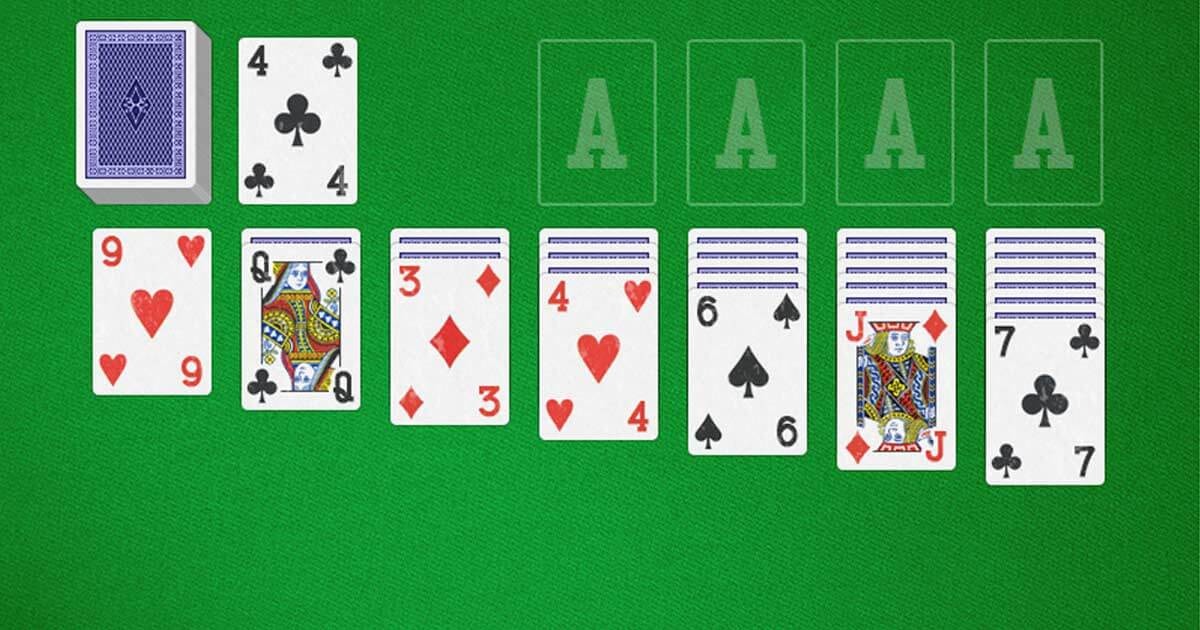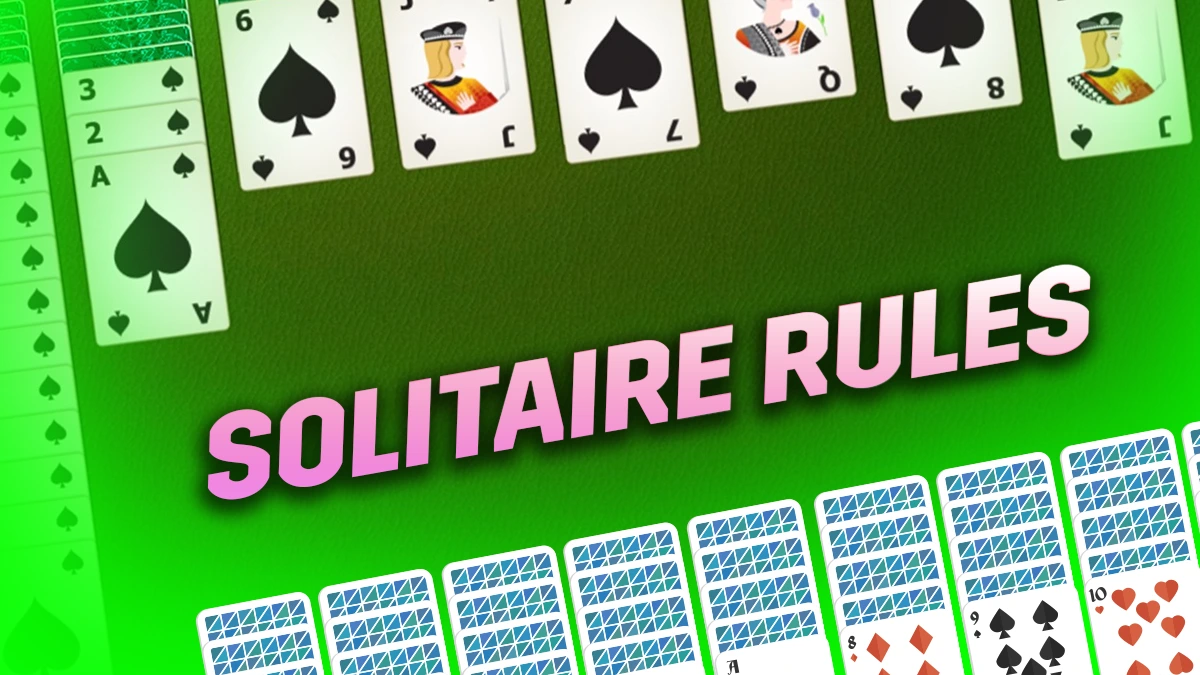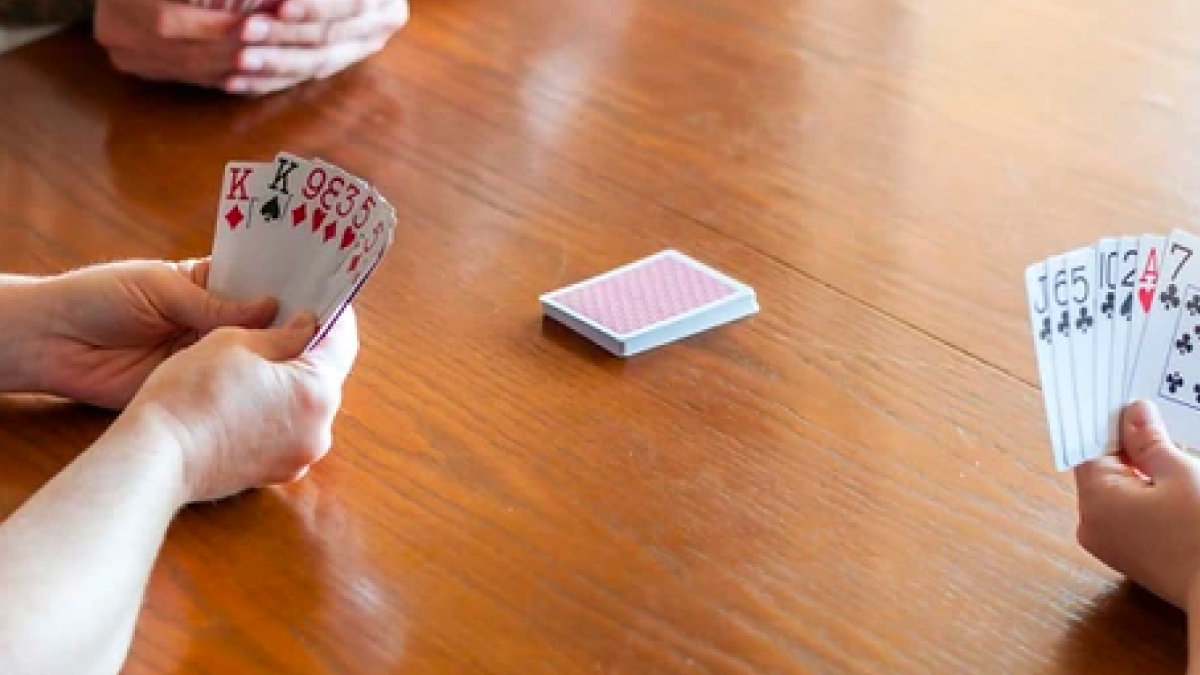Table of Contents
ToggleSolitaire is a popular single-player card game. It has become available worldwide through Windows in-built games. Solitaire is played solo, making it quite accessible. This could explain the game’s popularity with people of all ages. Those who love card games find Solitaire the best alternative. As it involves skill and subtle strategy at every step, the game has come to appeal to even the intelligent. Moreover, solitaire rules are highly adaptable, giving birth to as many variations as 500+.
The general term “Solitaire” refers to the Klondike solitaire game. Even in Klondike solitaire, there are 1- and 3-card variations with varying difficulty levels. The core rules, card movement, and general arrangement remain the same in many variations. Learning how to play Solitaire is intellectually stimulating while playing Solitaire is engaging and rewarding.
How to Play Solitaire Game Card Game

When we refer to playing Solitaire, we generally mean playing the Klondike version of the game. Though there are plenty of variations to the game, there are some standard rules regarding the movement of cards. Let’s learn how to play the solitaire game, starting with the important terms.
Know More : How To Play Spider Solitaire 1-Suit
Solitaire Terminology
Foundation: The piles where cards are built up by suit, typically from Ace to King. There are four foundation piles in Klondike.
Tableau: The main area where 7 piles of cards are arranged in columns, and the primary play occurs.
Waste (or Discard Pile): This is the Pile where cards from the stock are placed when they are not immediately playable.
Stock (or Draw Pile): The Pile of face-down cards from which cards are drawn.
Objective
The goal of Klondike Solitaire is to move all cards to the four foundation piles, one for each suit (hearts, diamonds, clubs, spades), in ascending order from Ace to King.
However, many cards needed to solve the game are trapped in the tableau, stock, and waste piles. You must pick up the right cards at the right time by following the rules for manipulating cards in respective piles.
Setup
- Solitaire is a solo game that you can play by yourself. The setup is also simple: get a standard deck of 52 cards and choose a neat surface as a play area.
- Deal cards into 7 columns in ascending order to form tableau cards for the solitaire setup. The remaining cards form the stockpile. Shuffle the 52-card deck well. To create a tableau, follow the below steps, for tableau setup is part of the gameplay.
- Column 1: 1 card, face up.
- Column 2: 2 cards, with the top card face up and the rest face down.
- Column 3: 3 cards, with the top card face up and the rest face down.
- Continue this pattern until Column 7 has 7 cards, with only the top card facing up.
- Place the remaining deck of cards in a stockpile in a down position.
Game Play
The ultimate objective of playing Solitaire is forming foundation piles. To arrange the foundation, you have to move cards from respective piles. The answer to “how to play solitaire game” is understanding the rules for moving the cards from those piles.
Moving Tableau Cards
In the solitaire game, most of the action happens around the tableau cards, where there is maximum movement. The following solitaire rules apply:
- Cards with alternating colors can only be placed on top of each other in descending order.
- Movement in any tableau starts with only the top card facing up.
- You can move a lower card, or a group of cards, onto a higher card in another column. For example, You can move a 4 of Spades onto a 5 of Hearts.
- You cannot place a higher card or group of cards underneath a lower card or group, e.g., a 7 of Diamonds under a 6 of Clubs.
- If all face-up cards in a column are moved and only face-down cards remain, flip the top face-down card to make it playable.
- Only a King can be moved into that space if a column becomes empty. No card lower than that can be placed in empty spaces.
- You cannot have more than 7 columns in the tableau.
- Cards in the tableau can be moved to the foundation piles as long as they follow the rules (same suit and ascending order).
Moving Draw Pile
- Draw a card from the stockpile if no moves are possible in the face-up cards.
- Depending on the variation you’re playing, you may draw one or three cards at a time.
- If the drawn card can be played on the tableau or foundations, do so. If not, place it in a separate pile known as a waste pile.
- Once the stock pile is exhausted, you can reshuffle the waste pile to form a new stock (in some versions, this can be done only a limited number of times).
Forming Foundation Piles
- You start building the foundation piles with Aces placed in their respective foundation piles.
- Cards must be added in ascending order by suit (Ace, 2, 3, …, King).
- You can move cards from the tableau or waste to the foundations if they fit the sequence.
Continue Moving Cards
- Keep moving cards between the tableau, foundations, and waste until you either win by building up all four foundations or run out of possible moves.
Read More: How to Play Solitaire Cube Like a Pro
Solitaire Rules to Bear in Mind
Handling Tableau Cards
- The cards in the tableau column must be arranged in descending order from top to bottom, with alternating colors. When a card is red, the card immediately below it should be black.
- Every tableau sequence must start with only a King.
- You can move single cards or groups of cards to a new column with a higher number if they follow the rules of descending order and alternating colors. It is useful when you have to reveal face-down cards.
- You cannot move higher cards or groups of cards underneath a lower column.
Draw Pile and Waste Pile
- Flip three cards from the draw deck (unless you’re playing the more accessible version where you flip one card at a time and see all three cards).
- Cards from the waste pile can be played to the tableau or foundation piles as long as they follow the correct sequence and suit rules.
- When the draw deck runs out, turn the waste pile over to form a new draw deck without shuffling.
Dealing with Foundation Piles
- Each of the four foundation piles must hold only one suit. Each Pile should contain cards of the same suit.
- Cards in the foundations are arranged from Ace (the lowest) to King (the highest).
- You can move cards from the foundation back to the tableau to rearrange them or create a sequence, but they should maintain the correct sequence.
Winning the Game
The game ends when all cards are moved to foundation piles and sorted into individual suits. You will win the game. No more moves are possible at this moment. As there is no opponent, most online solitaire games make it challenging by keeping a timer—you will win only if you can make foundation piles within a fixed time.
Solid Strategies to Win Solitaire
- Prioritize Exposing Face-Down Cards: Focus on moving cards to reveal face-down cards in the tableau. This increases your chances of making more moves and uncovering hidden cards.
- Build Sequences Wisely: When stacking cards, arrange them in descending order and alternating colors. This helps create longer sequences and makes uncovering and using more cards easier. It would be best to be alert and move the sequences wisely to expose tableau cards.
- Use Empty Columns Wisely: Only move a King to an empty tableau column if it helps you uncover face-down cards or creates new moves. Avoid filling empty columns with cards that won’t be useful.
- Manage the Stock Pile: Draw cards from the stockpile carefully. If you can cycle through the stock multiple times, use this to your advantage to uncover valuable cards. If limited, plan your moves to minimize the number of cycles needed.
- Move Cards to the Foundation Early: As soon as possible, place Ace Cards and cards that can help build sequences in the foundation piles. This clears space in the tableau and allows more cards to be moved around.
- Avoid Moving Cards Prematurely: Don’t move cards to the foundation unless it’s beneficial for progressing the game. Keeping a card in the tableau can sometimes open up more strategic moves. When learning how to play solitaire games, the goal is to expose as many face-down cards as possible to finish the game efficiently.
- Create and Use Tableau Sequences: When building sequences in the tableau, try to create longer runs of cards. Longer sequences help reveal more face-down cards and provide flexibility for future moves.
- Balance the Tableau: Try to balance your tableau columns by not letting one column get too tall. This will help you manage your moves more effectively and prevent you from getting stuck.
- Think Ahead: Plan your moves ahead of time. Consider how each move will affect the tableau and stockpile, and try to anticipate the results of each potential action.
- Clear the Stock Pile: If possible, clear the stockpile to gain access to all available cards. This lets you see all potential moves and make better decisions throughout the game.
Useful Insights
- If you find Aces in Tableau, there is no need to play aces and move them to the foundation immediately. Sometimes, it’s strategic to leave it in place.
- Remember, you can move partial builds of cards between tableau columns, not just single cards or complete sequences.
- Pay attention to the order of cards in the waste pile, as it can affect your future moves.
- Not all deals are winnable in Solitaire. Some estimates suggest only about 80-90% of games are theoretically winnable. However, the percentage can change based on specific rule variations, like the number of cards drawn from the stock or restrictions on recycling the waste pile.
Also Read : 30 Types of Solitaire Games You Must Try
Solitaire Variations
Solitaire rules are highly adaptable, which has led to many variations of the game. There are 500+ variations of solitaire. Let’s discuss the
Spider Solitaire
After Klondike, Spider is the most popular solitaire game. It is a more complex variation of the game that uses two decks of cards. The objective is similar to Klondike: you must create sequences of cards in descending order, from King to Ace, within the tableau. Completed sequences are removed from the play. Spider solitaire comes in varying difficulties, with 1, 2, or 4 suits catering to different skill levels. Given the two-deck format, the game requires careful planning and patience.
FreeCell
FreeCell Solitaire is a highly strategic variation known for its almost universal solvability—most deals can be won with the right strategy. The game is played with a single deck, with all cards dealt face-up into eight tableau columns at the start. Four free cells allow temporary storage of individual cards, giving players more control over the game. The objective is to move all cards to the foundation piles, organized by suit in ascending order.
Pyramid Solitaire
Pyramid Solitaire offers a unique twist on the traditional format with its distinctive pyramid-shaped tableau. The objective is to remove pairs of cards that add up to 13, with Kings being worth 13 and removed individually. Only uncovered cards, those not overlapped by others, can be paired and removed. The game ends when all pairs have been matched, or no more moves are possible. Its simple rules but challenging gameplay make it a fun and engaging variation.
TriPeaks Solitaire
TriPeaks Solitaire combines elements of strategy and speed, offering a fresh take on the classic Solitaire game. The tableau is arranged into three overlapping peaks, and the goal is to clear all the cards by selecting those that are one rank higher or lower than the active card. When no further moves are possible, cards are drawn from the stockpile to create a new active card. TriPeaks is known for its fast pace, as players quickly scan for possible moves to keep the game flowing.
Conclusion
Among card games, Solitaire stands out with its emphasis on skill and strategic thinking. Every move and every step of the game requires insights if you want to finish the game early. Many online solitaire card games have a timer to make the game more challenging for players. But if you know the basic rules standard in solitaire games, varying difficulty levels only call for using higher intelligence. Once you understand it, no one can stop from enjoying it.
Read More: Klondike Solitaire Turn 3: Rules and Winning Tips
FAQs
What is a solitaire game?
Solitaire is a single-player card game mostly played with cards, though it can also be played with dominoes, marbles, or pegs. You might have been familiar with the game from Microsoft games. It is also called patience in Europe. The game has many versions, but the Klondike solitaire version is the most popular. Generally, when people refer to Solitaire, they refer to the Klondike version.
What are the popular versions of solitaire games?
There are over 500 solitaire variations. However, Koldike, Spider, Free Cell, Pyramid, Tripeaks, and Yukon are the most popular versions, each having unique rules and challenges. These solitaire games are enjoyed for their strategic play and varied difficulty levels.
How many cards are there in classic solitaire?
The solitaire game uses a standard deck of 52 cards without any jokers. Twenty-eight cards are dealt out in 7 tableau piles, while the remaining 24 are kept in a stockpile.
Is Solitaire good for your brain?
Yes, Solitaire can be good for your brain. It is one of the reasons it has become popular among people of all ages. It promotes strategic thinking, problem-solving, and concentration. It also provides a mental break, reducing stress.
How to play solitaire by yourself?
Most solitaire games are single-player games only. You can play them anytime, all by yourself, just by learning the rules.
What to avoid in Solitaire?
Solitaire gameplay requires patience and strategic planning. To win, avoid making random decisions, neglecting potential plays, and focusing on immediate gains. Also, avoid making hasty decisions or overlooking card sequences.
How to play solitaire for kids?
Solitaire card games are suitable for children over 8 years of age. To simplify the game, kids can flip over every card instead of every three cards. More accessible variations, like 7-Up, are also available.








